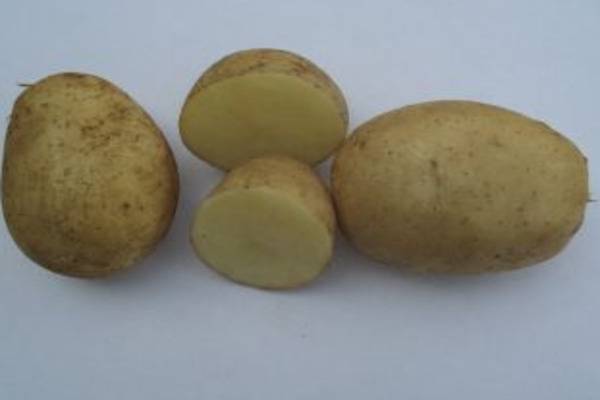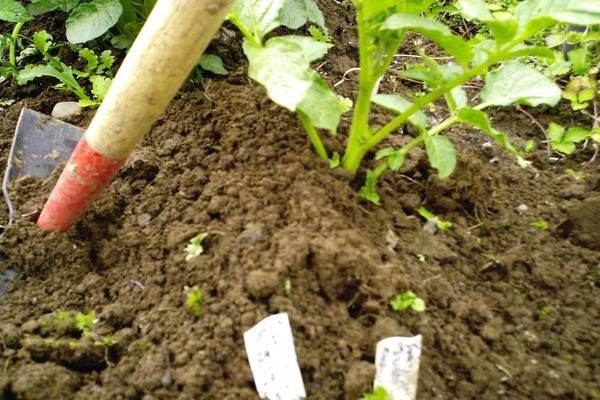Content
Arizona potatoes are a Dutch breeder's product. The variety grows well in the regions: Central, Central Black Earth. Suitable for planting in Ukraine and Moldova.
Description
Arizona potatoes are an early table potato. Bushes are formed of medium height, with straight, spreading stems. The leaves grow quite large.
Massive oval tubers per season gain weight on average 110-150 g. The skin of the potatoes is yellow, small eyes remain on the tubers. Light yellow pulp (photo). The starch indicator corresponds to table varieties - 13-16%. The ripening period of the crop is 70-85 days. The Arizona potato variety is excellent for winter storage (keeping quality 95%).
Advantages and disadvantages
When evaluating the Arizona variety, gardeners identified several advantages:
- excellent presentation;
- good preservation;
- drought-resistant;
- does not lose its presentation during long-distance transportation;
- resistance to golden nematode and potato crayfish.
The disadvantages of the Arizona potato variety include sensitivity to common scab, late blight of leaves.
Landing
An important stage before planting the Arizona variety is the processing and germination of tubers. Select healthy, undamaged material. In order for the sprouts to grow faster, the potatoes are taken out to a warm, well-lit place.
A widespread and popular remedy is Epin. Arizona potato tubers, treated with the preparation, withstand late frosts up to -5 C. Bushes grow more powerful and strong, and root crops ripen faster. For spraying, one ampoule (0.25 ml) is diluted in 400 ml of water. This amount is sufficient to process approximately 200 tubers. The procedure is carried out one day before planting Arizona potatoes.
An illuminated place is allocated for potato beds. Preferably not acidic soil. Observance of crop rotation is an important factor in obtaining a good harvest. Potatoes grow well after onions, cabbage or various greens.
The Arizona variety is planted in the first half of May - when the soil has warmed up enough. The site must be prepared - loosened, removed weeds... On the landing day, the soil is treated with a solution of potassium permanganate. The tubers are also sprayed with special agents. Fungicide "Matador" will protect planting material from the Colorado potato beetle, wireworm, late blight, Alternaria. Dilute 30 ml of the product in 200 ml of water - this is enough for spraying 30-35 tubers. In order for the processing to be of high quality, Arizona potatoes are laid out in one layer and sprayed first on one side, and then on the other.
A little peat mixed with humus is added to the holes approximately 10 cm deep. The row spacing is made 65-70 cm wide. And in a row, a distance of 25-30 cm between the pits is maintained.
Care
Arizona potatoes are quite unpretentious. However, compliance with some care rules will help increase yields:
- for better growth of potatoes, high beds are formed;
- after watering, the soil must be mulched;
- about 5-7 days before digging up the roots, the tops are cut off.
Several factors influence the choice of the irrigation regime: the climatic characteristics of the area, the composition and structure of the soil. If rains are frequent, then there is no need to specially water the plantings of Arizona potatoes.It is better to loosen the soil regularly. Loosening is also called "dry irrigation", because it retains soil moisture.
When growing the Arizona variety in any region, it is important to carry out agrotechnical techniques and plant feeding on time.
Hilling and feeding
The first time hilling is carried out when the potato stalks grow 15-20 cm high. The second time (after 2-3 weeks) the earth is carefully loosened and rolled onto the stalks, forming mounds.
What is noteworthy is that hilling is important when growing potatoes of the Arizona variety in regions with different climatic characteristics. In arid areas, this will prevent the soil from overheating and help keep it moist. And in places with cool and rainy weather, thanks to hilling, the earth will loosen, which will ensure the flow of air to the root crops.
Fertilization
Experienced gardeners recommend feeding the plants three times a season:
- As soon as the shoots of Arizona potatoes appear, nitrogen-containing formulations are used. Pale foliage is a signal of a lack of nitrogen. You can use a solution: 500 ml of mullein and 15 g of urea are diluted in 10 liters of water. Pour 500 ml of the mixture under each bush.
- During bud setting, potassium-based fertilizers are applied. This will help set and grow tubers. In 10 liters, 15 g of potassium sulfate and double superphosphate are diluted, half a glass of wood ash. For one bush, 500 ml of solution is enough.
- Approximately 20-25 days before digging out the crop of Arizona potatoes, a mineral-organic mixture is introduced. For 10 liters of water, take 30 g of superphosphate and a glass of slurry. For one bush, 50 ml of fertilizer is enough.
The best option is a combination of the process of applying top dressing and hilling bushes.
Diseases and pests
To obtain a large and high-quality harvest, it is important to notice the signs of the appearance of diseases in time and use the right means to combat dangerous insects.
Late blight (brown rot) easily affects the plant. In favorable conditions, when the weather is warm and humid, it quickly affects the entire planting. The source of rot can be soil, infected tops, infected neighboring plants (especially the Solanaceae family). The initial signs are darkening of the lower leaves on the bushes. The whole plant (aboveground part and root system) is gradually affected. It is necessary to start the fight for the harvest when the first planting symptoms appear, they are sprayed with fungicides: Skor, Ditan, Bravo, Reglon super. Preventive measures are of particular importance - the rules of crop rotation are observed, Arizona potatoes are not planted in the lowlands, the beds are not allowed to thicken, the bushes are spud.
Common scab is a fungus that affects the skin of tubers. The disease leads to the loss of the marketable type of tubers of the Arizona variety, the taste of potatoes deteriorates, the amount of starch decreases, and the keeping quality of root crops decreases. The disease develops in dry, hot weather. Control methods: the use of physiologically acidic fertilizers (manganese sulfate, ammonium sulfate), culling of infected tubers during planting, regular irrigation of the soil (especially after the budding phase).
Colorado potato beetle and its larvae eat the green part of the potato, which leads to the destruction of the bush. The insect hibernates in the ground and as soon as warm weather sets in, it gets to the surface. If the plantings of Arizona potatoes are small, then you can manually collect insects and larvae. A more effective method is the use of biological agents. The beds are sprayed with Agrovertin, Bicol, Colorado.Popular folk remedies are the treatment of bushes with a solution of birch tar (100 g of the product is diluted in a ten-liter bucket of water), an ash-and-soap solution.
Harvesting
The tops are mowed approximately 7-10 days before the tubers are dug out, which accelerates their ripening. Harvesting is desirable in dry weather. The best root crops are left for planting for the next season. Sick and damaged potatoes are thrown away.
In order for Arizona potatoes to dry, they are left on the field for 1-2 hours, provided that the air temperature is low. On a bright hot day, it is better to scatter the crop under a canopy, otherwise burns may appear on the fruits.
The Arizona variety is very popular for its easy care, excellent growth at low temperatures.
Testimonials














